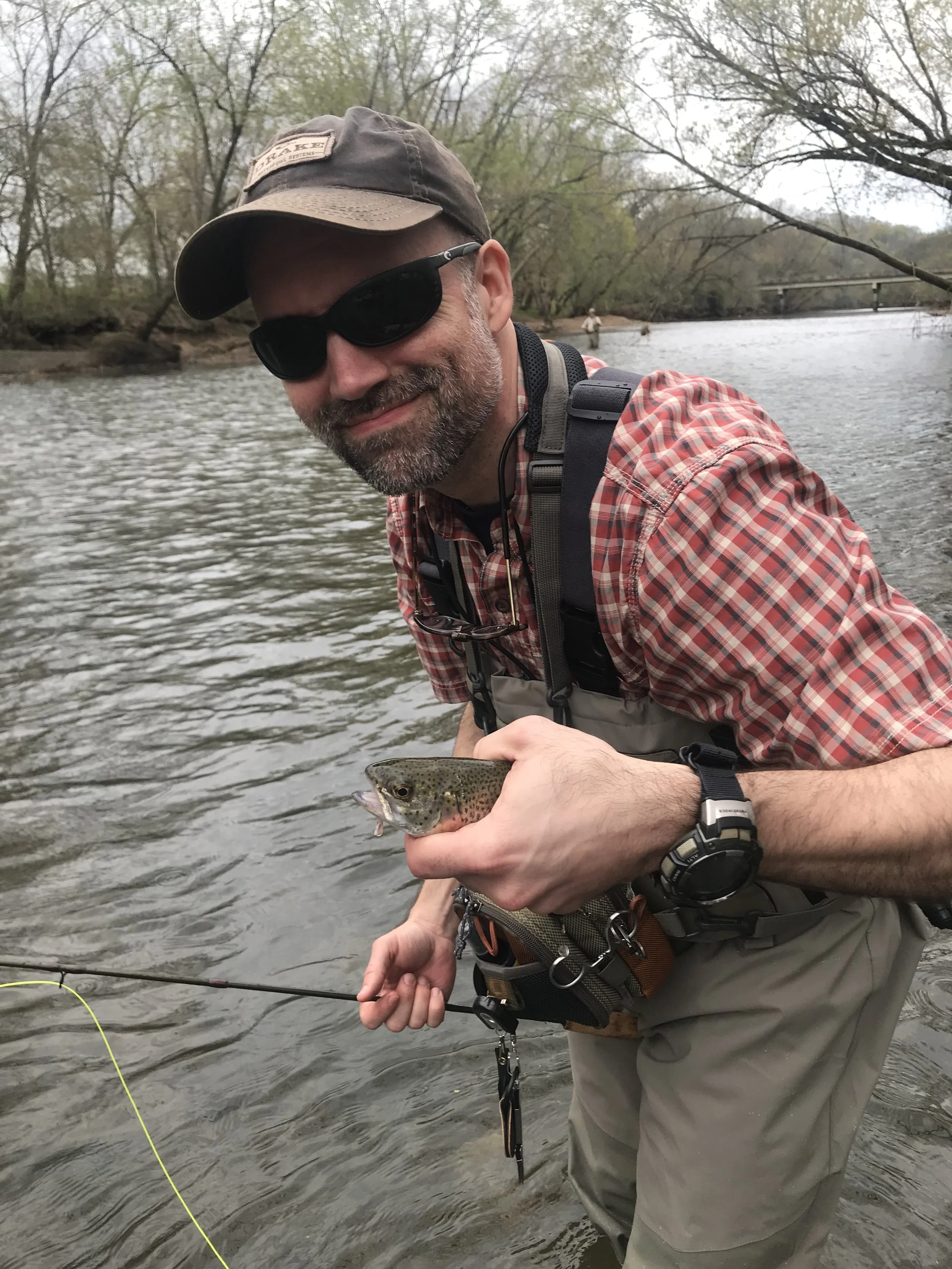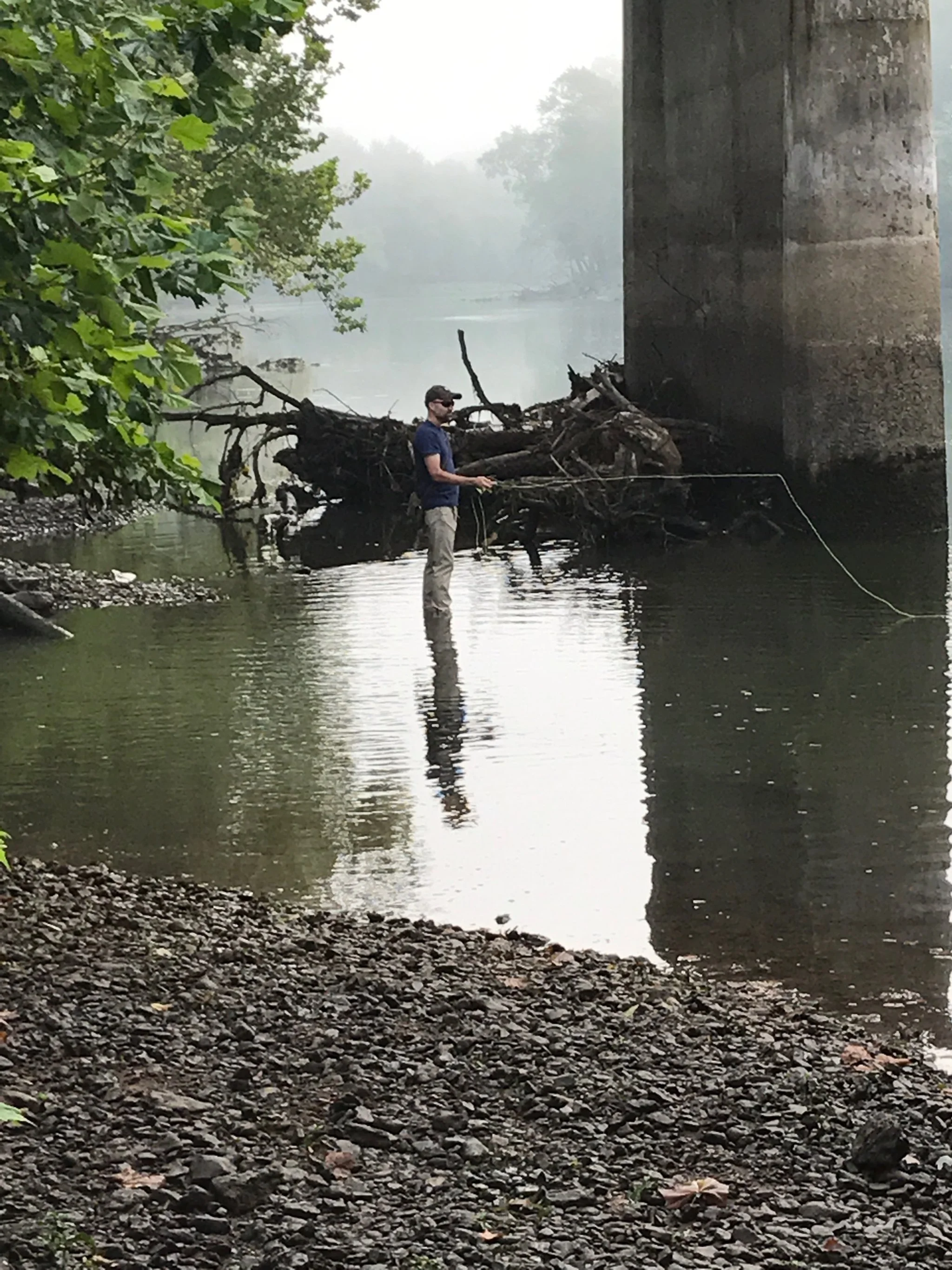Philosophy of Teaching
Got one in the net!
My identity as a teacher began over twenty years ago when I taught music to second and third graders. Subsequently, I have grown as a teacher and taught diverse groups in different settings, covering multiple topics. Since I am passionate about teaching, I felt it appropriate to liken my teaching philosophy to another passion – fly fishing.
Fly fishing is a specialized way of angling that requires unique tackle and talent. It is not enough to merely buy a fly rod and hit the water with high expectations. Indeed, it takes hours of practice and a mentor or two to master the fine art of fly casting. Likewise, growing into a competent counselor requires extensive training and guidance that is “caught” as much as it is “taught.” So, as a counselor educator, I understand the value of the student-teacher relationship in this process and its contribution to student growth and motivation; therefore, I seek to be engaging and caring with students while being mindful of proper boundaries. I desire to mentor students into the profession, modeling what is required to succeed as a professional counselor and student. Part of this modeling includes equipping myself for class by immersing myself in the topic I am teaching and consequently arriving at class well-prepared. In doing this, I hope to not only competently equip students but also model for them that professionalism takes preparation in educating oneself as well as putting in the time. Functioning as a mentor, I hope to convey to my students that they will always have room to improve their craft. By the very nature of my interactions, I seek to model for students how to provide positive feedback and handle difficult discussions with their peers and others. Finally, I hope my enthusiasm for teaching passes along a love for learning and a passion for the profession they seek to enter.
“To him, all good things – trout as well as eternal salvation- come by grace, and grace comes by art, and art does not come easy.”
– Norman Maclean from the book A River Runs Through It
Fish on the line
Knowing a river is essential, but fly fishing also requires appreciating the fish being pursued. Though fly fishing is commonly associated with trout, the reality is this method of fishing can be used to catch all manner of fish. The critical point is to understand the changes in the fish’s behavior according to the season and stage of life. Similarly, I believe knowing the students I am teaching is essential. This helps to create a safe, inclusive learning environment. So, whenever possible, I choose to know students by name and have at least a basic understanding of what has drawn them to the counseling profession. This promotes an understanding of the students and helps them know I care about them as an individual. I seek to be aware of the generational, cultural, and gender makeup of the class and use multiple teaching approaches to help encourage participation from everyone. Hence, I will use techniques such as think-pair-share, surveys, or have students write down questions they have at the end of class to promote an environment that feels safer to participate in for everyone.
“I have many loves and Fly-Fishing is one of them; it brings peace and harmony to my being, which I can then pass on to others.”
– Sue Kreutzer
My first attempt at tying flies.
When fly fishing, your presentation of the fly can make a difference in the fish striking the fly or not; therefore, the fly must closely mimic the insect you are trying to emulate in both form and function. Presentation can also make a difference between learning and not learning, being engaged or disengaged, and having material that is memorable or forgetful. Keeping this in mind, I engage students through active learning, discussions, and small group work. I seek to keep my students engaged with well-designed PowerPoint slides and the use of relevant movie, television, or YouTube clips to illustrate a point. Technology is an important component of a modern learning environment, and I try to use and keep abreast of new ways to integrate technology into my teaching. My ample use of storytelling and humor enables me to engage most students, even when lecturing. I use stories that are often humorous, at times poignant, but always relevant to the topic. Indeed, I have had people tell me they remember points I make because of my use of storytelling. Stories have a way of connecting the practical to the theoretical and the classroom to the real world. Overall, I have found humor, and stories are a way to connect with most students, regardless of background, culture, or gender.
“Some go to church and think about fishing, others go fishing and think about God.”
-Tony Blake
Got him in!
Successful fly fishing requires planning; part of that preparation involves learning about the river you are fishing. Although all rivers share some common features, each river has qualities that make it unique. From understanding the path the water travels to the life it supports, the wise learn to study the river’s ways and adapt appropriately. At times, this can make the difference between an exciting or lackluster day on the water. In the same way, when I am teaching, I want to understand the class and the setting so I can adjust appropriately.
Regarding learning, I do not believe in a “one-size-fits-all approach.” As I get to know a class, I seek to recognize “the personality” of the group, identifying the students’ backgrounds, experiences, and ways of learning. I strive to make the learning experience feel personal, allowing each student to connect the material to their previous knowledge and experiences. Moreover, understanding students’ backgrounds can help me guide discussions, enabling each student to learn and experience something from the perspective of their peers.
“For the supreme test of a fisherman is not how many fish he has caught, not even how he has caught them, but what he has caught when he has caught no fish.”
– John H. Bradley
Sometimes you don’t need waders!
Another quality of rivers is that they do not exist in and of themselves. They flow into one another and then into larger and greater bodies of water, ultimately becoming a part of the water cycle that helps sustain life throughout the world. Similarly, I want students to understand how each class pours into other classes throughout their education, and ultimately how it ties into a greater body of knowledge. They should not see each class as a river that flows nowhere. Instead, I want to help them see how each class and field of study can contribute to a greater understanding of every other class or field of study and vice versa. I hope to encourage students to avoid being one-dimensional - only able to see from their own perspective and field of study. Instead, I want them to recognize the value of multiple interpretations and appreciate the inherent value of knowledge from diverse viewpoints, realizing that each perspective helps to clarify their own understanding. Furthermore, it means helping counseling students see from both the macro- and micro levels. For example, they must be able to identify and speak to the systems that contribute to society while also understanding the impact those systems can have on the individual or family. In the end, through group work, class discussions, and interactions, I hope students learn that they are not a river unto themselves, as they need to pour into others and accept others pouring into them.
A final consideration for fishing and teaching is how one measures success. Success in fishing can be measured in many ways – from landing your limit to catching just one trophy fish. Some people, including myself, view success as any day you are able to get out on the water. Success in teaching can also be measured in many ways beyond a standard test. For example, having the students write down and turn in their questions at the end of each class can help me identify where there are gaps in comprehension. Research and position papers, along with short essay tests, allow students to demonstrate and defend the material they have synthesized. Considering my own success in teaching, I believe I must strive for continuous improvement. So, I can determine my success by gauging how much students learned at the end of each class period, I can incorporate feedback from students at the end of a course and receive feedback from more seasoned instructors. But overall, at least in my view, success in teaching is just like fishing - any day spent teaching is a day well spent.
“They say you forget your troubles on a trout stream, but that’s not quite it. What happens is that you begin to see where your troubles fit into the grand scheme of things, and suddenly they’re just not such a big deal anymore.” – John Gierach





